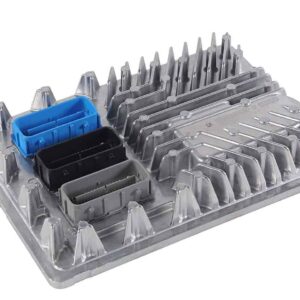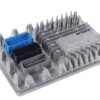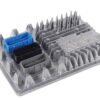Restore Your Vehicle’s Core Performance and Reliability
Is your Escalade, Sierra, or Tahoe suffering from frustrating, hard-to-diagnose issues? A check engine light that won’t go away, erratic engine behavior, poor fuel economy, or even a no-start condition can often be traced back to a single, critical component: the Engine Control Module (ECM). As a technician with over two decades of experience under the hood, I’ve seen firsthand how a failing ECM can mimic a dozen other problems, leading to wasted time and money on unnecessary parts. This isn’t just a computer; it’s the brain of your engine, and when it falters, the entire vehicle suffers.
This genuine GM Engine Control Module, part number 12686382, is the definitive solution. We take the guesswork and dealership hassle out of the equation. Before this module ever leaves our facility, we program it with the latest official GM software, specifically calibrated to your vehicle’s unique Vehicle Identification Number (VIN). This ensures seamless communication between all your vehicle’s systems, restoring the precise engine management, transmission shifting, and emissions control that the factory intended.
Is Your GM Vehicle Showing These ECM Failure Signs?
- ✔ Check Engine Light (CEL) illuminated with codes like P0601 (Internal Control Module Memory Check Sum Error), P0606 (ECM/PCM Processor Fault), or U0100 (Lost Communication With ECM/PCM).
- ✔ Unexplained drop in fuel mileage.
- ✔ The engine cranks but refuses to start.
- ✔ Rough idling, stalling, or hesitation during acceleration.
- ✔ Harsh or erratic automatic transmission shifting.
- ✔ Performance issues that seem to come and go without a clear pattern.
A Technician’s Notebook: The Ghost in the Machine
I remember a 2017 Silverado 1500 that came into the bay with an intermittent stalling problem that no one could figure out. The owner had already replaced the fuel pump and a few sensors. The truck would run perfectly for days, then suddenly die at a stoplight. No codes were stored. On a hunch, I monitored the live data stream from the ECM and noticed the 5-volt reference signal would momentarily drop out, just for a split second, right before a stall. The original ECM had an internal short that only appeared when it reached a specific temperature. We installed a VIN-programmed module just like this one, performed the crankshaft and theft relearns, and the problem was solved for good. It’s a classic example of how a faulty 2017 Escalade ESV ECM or its equivalent can create phantom issues.
Your Straightforward ECM Installation Guide
Replacing your ECM is a manageable job for a confident DIYer or a quick task for any professional. With our pre-programming, the most complex step is already done. You will, however, need access to a GM-compatible scan tool or software like TIS2WEB/Techline Connect to perform the final security relearn.
- Safety First: Disconnect the negative terminal from your vehicle’s battery and secure it away from the post to prevent any accidental contact.
- Locate the ECM: On most trucks and SUVs like the Tahoe or Sierra, the ECM is located in the engine compartment on the driver’s side, often near the firewall or inner fender. On vehicles like the Corvette, it may be in the cowl area.
- Disconnect and Remove: Carefully unplug the electrical connectors. Most have a locking tab or lever that needs to be released. Once disconnected, unbolt the module from its mounting bracket.
- Install the New Module: Bolt the new, pre-programmed ECM into place. Reconnect the electrical harnesses, ensuring they click securely into position.
- Reconnect Battery: Reattach the negative battery terminal.
- Perform Relearn Procedures: This is the most critical step. The vehicle will not start until the Vehicle Theft Deterrent (VTD) system is synchronized with the new ECM. This requires a tool with GM programming capabilities. At this time, it is also best practice to perform any other necessary initializations, such as the Crankshaft Position Variation Relearn, to ensure optimal performance.
Verified Fitment For Your General Motors Vehicle
This module is a direct replacement for part number 12686382 and is also compatible with part numbers 12692068, 12704476, 12674052, 12674472, and 12678815. It fits a wide range of popular GM models. Please verify your vehicle and options below:
- Cadillac ATS (2017): 3.6L (VIN Y, LF4)
- Cadillac CTS (2017): 6.2L (Supercharged) or 3.6L Twin Turbo (VIN 8, LF3)
- Cadillac Escalade / ESV (2017)
- Cadillac XTS (2017): 3.6L (VIN 8, LF3)
- Chevrolet Corvette (2017)
- Chevrolet Silverado 1500 (2016-2018)
- Chevrolet Suburban (2017)
- Chevrolet Tahoe (2017)
- GMC Sierra 1500 / Denali 1500 (2016-2018)
- GMC Yukon / Yukon XL (2017)
By purchasing a properly programmed 2017 Escalade ESV ECM, you’re not just buying a part; you’re investing in a reliable repair that restores your vehicle’s designed functionality and gives you peace of mind on the road.
Frequently Asked Questions
Do I really need to provide my VIN?
Yes, absolutely. Your VIN is essential for us to load the correct GM-certified software and calibrations for your specific engine, transmission, and options. This step is what makes the installation process so much smoother than using a generic or junkyard module.
What is a Vehicle Theft Deterrent (VTD) relearn?
The VTD relearn is a security procedure that synchronizes your new ECM with the vehicle’s ignition keys and Body Control Module (BCM). Without this step, the vehicle’s security system will assume a theft is in progress and will prevent the engine from starting. It requires a professional scan tool with GM software (like Techline Connect).
Can I perform the theft relearn myself?
If you are a professional technician or an advanced DIYer with access to GM’s TIS2WEB or a high-end bidirectional scan tool (like a Snap-on, Autel, etc. with programming capabilities), you can perform the procedure. For most vehicle owners, this step will need to be completed by a qualified repair shop.
Will this fix my check engine light?
If the check engine light is caused by an internal failure of the original ECM (e.g., codes P0601, P0606), then yes, this part is the correct fix. However, it’s always crucial to perform a full diagnosis, as other faulty sensors or wiring issues can also trigger a check engine light.
Is this part difficult to install?
The physical installation is straightforward, typically involving a few bolts and electrical connectors. The main challenge is the requirement for the electronic relearn procedures after installation. The mechanical part of the job is easy for anyone with basic tools.



